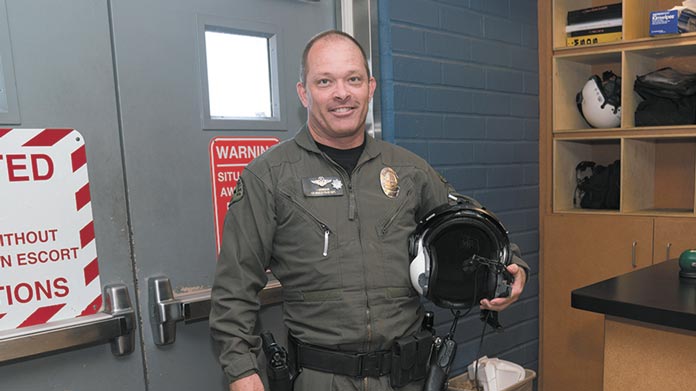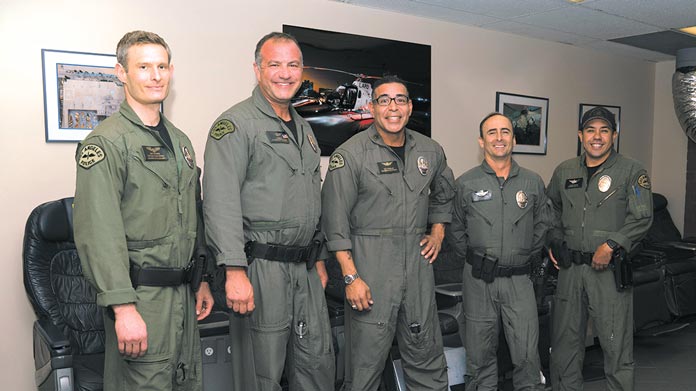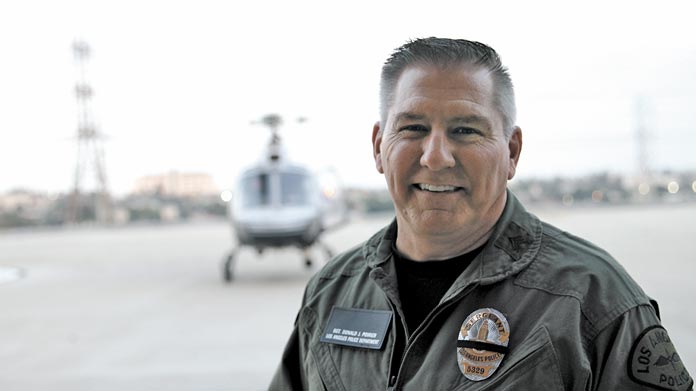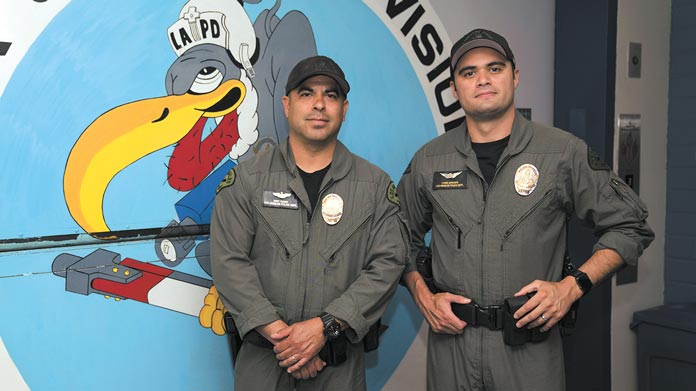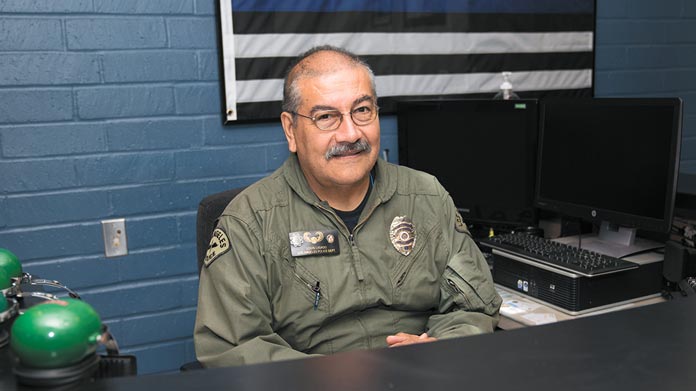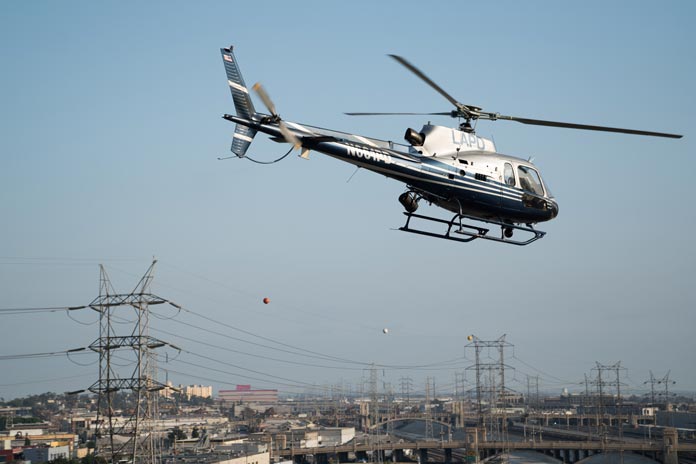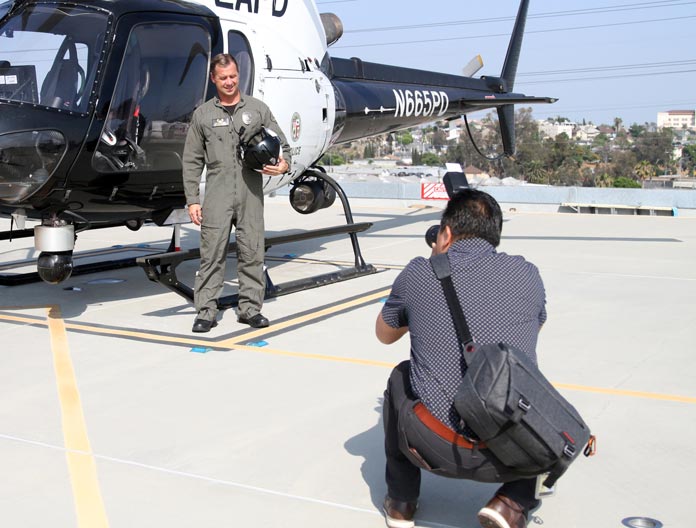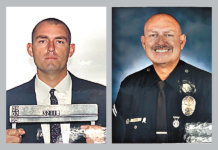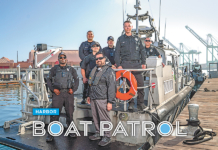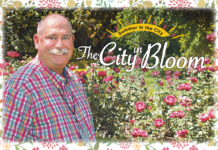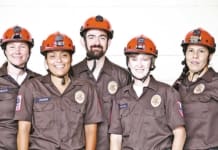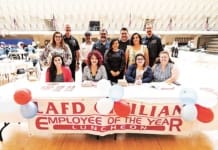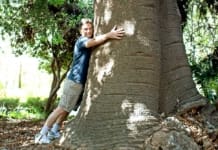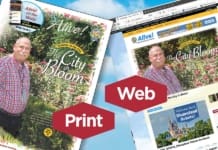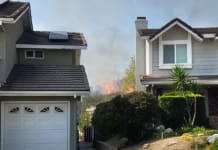Alive! photos by Summy Lam
Their presence is unmistakable – reassuring citizens and Officers on the ground that help has arrived, in a big way. And convincing bad guys that their criminal actions are soon to end.
They are the Pilots, Tactical Flight Officers and support staff of the LAPD’s Air Support Division, thundering in formidably from above. With its highly trained and experienced personnel, top-notch equipment, relentless training and first-rate ground staff, Air Support is the biggest and best municipal-based airborne law enforcement operation in the country.
Air Support Division provides air support to patrol and specialized units of the Los Angeles Police Dept. The unit enhances Officer and public safety, reduces the incidence of crime and thus reduces the fear of crime. It provides rapid response, tactical insight and airborne assessments of incidents, safely and professionally.
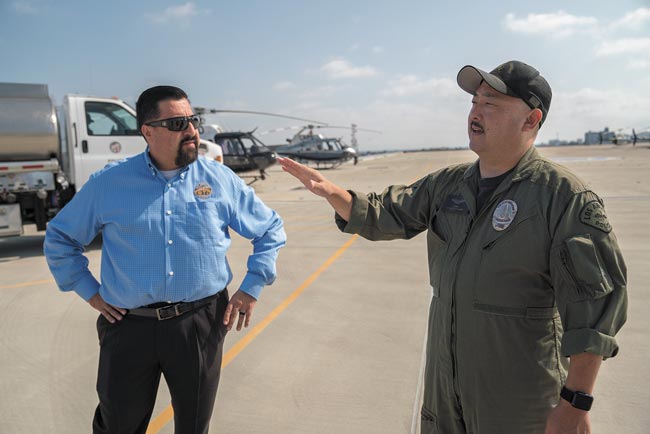
History
The LAPD’s airborne law enforcement program began with one helicopter in 1956. This helicopter, a Hiller 12-C, was assigned primarily for traffic patrol of the City’s freeway system and was assigned to the traffic Enforcement Division. In 1957 after a full year in operation, the “Helicopter Unit” flew 775 hours.
In 1963, a second helicopter was added to the fleet and two years later a third was added. In 1968, a turbine powered Bell 206A Jet Ranger was added to the fleet. This helicopter significantly decreased police response time. As a result, the “Helicopter Unit” began to respond to unusual occurrences and other police emergencies.
The “Helicopter Unit” experienced major expansion in 1974 and became officially designated as Air Support Division (ASD). Air Support Division consisted of 80 sworn personnel with 17 helicopters and a King Air fixed wing.
The fleet remained virtually unchanged until 1988 when the first Aerospatiale AS350B-1 was added to the fleet. Today at full capacity, the fleet consists of:
14 Airbus A-stars
2 Bell Jet Ranger B3s
1 King Air Fixed Wing
1 Bell Medium Lift
Proven
A study commissioned by NASA and conducted by the Jet Propulsion Laboratory’s (JPL) Space Technology Applications Office confirmed the study and report findings as follows:
-
- The number of Part 1 property crimes is reduced when an LAPD helicopter is overhead.
- The number of arrests associated with radio calls is three times higher with the involvement of LAPD aircrews.
- The citizens of Los Angeles accept helicopter patrols as a necessary part of the City’s police system and strongly favor their continuation.
- Department ground-based Officers universally support a strong airborne law enforcement program within the department.
In this month’s Alive! feature story, meet the crew, read the observations of Air Support Capt. Sean Parker, and ride along with the Alive! crew on patrol. |
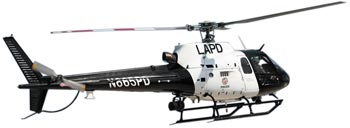 On June 18, Club COO Robert Larios and Club Director of Marketing Summy Lam went on a regular patrol with LAPD Air Support. Flying front seat were Officer Pilot Chris Mezich and Tactical Flight Officer Matt Sikorski.
On June 18, Club COO Robert Larios and Club Director of Marketing Summy Lam went on a regular patrol with LAPD Air Support. Flying front seat were Officer Pilot Chris Mezich and Tactical Flight Officer Matt Sikorski.
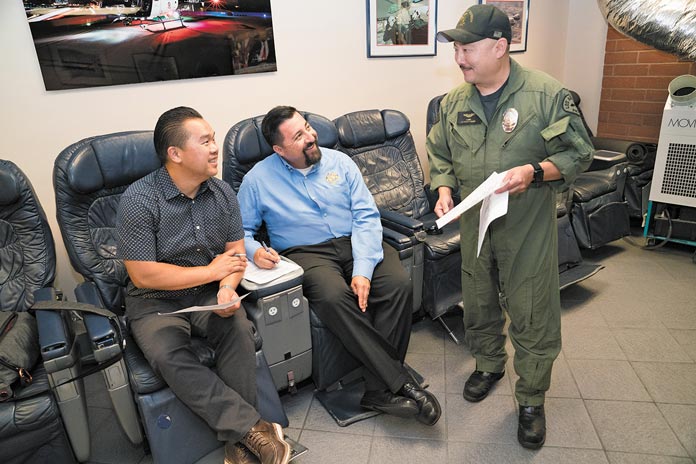

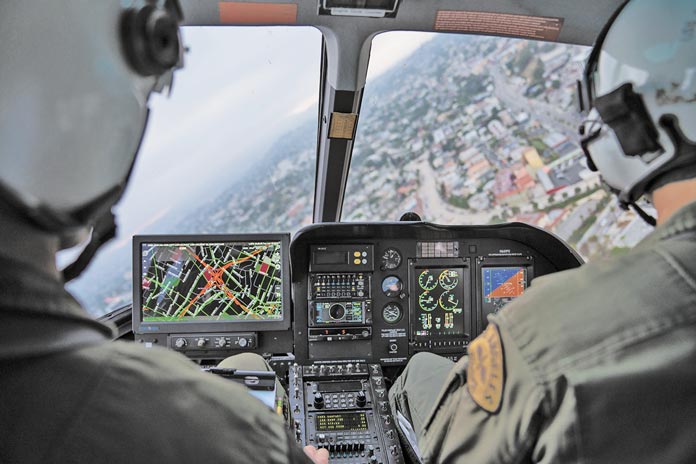
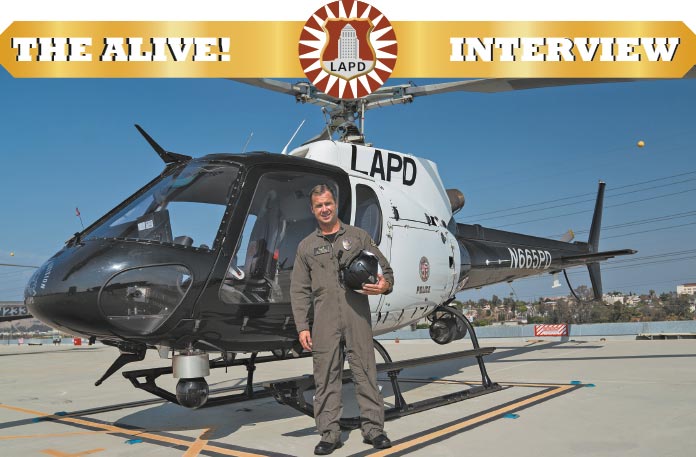
Quarterbacks in the Air
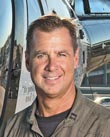
On June 18, Club COO Robert Larios and Alive! editor John Burnes interviewed Capt. Sean Parker, 23 years of City service, who’s in charge of the LAPD’s Air Support Division. The interview took place in Capt. Parker’s office in Piper Tech, the headquarters of the division.
Captain, thanks for hosting us today and speaking with us before we go on a ride-along later tonight.
Sure.
First, let’s start with your career path. How do you get here? Where did you get started?
I started off as a recruit, as a Probationary Officer. I started working at Pacific Division, then at Rampart Division. I’ve worked at 77th, Central and Hollenbeck, but I also had great opportunities to work specialized units like the vice unit and the gang unit, and I worked as a staff researcher drafting policies for the department. I’ve worked internal affairs, as an adjutant and on special projects, so I’ve had a lot of variety. I worked the back office of the Office of Operations, and then made Captain. I’ve been pretty lucky.
How did you come to Air Support?
We serve at the pleasure of the Office of the Chief of Police, so the needs of the department will guide where we’re assigned. There was a need for a Captain here at Air Support Division, and the Chief asked me to work it.
How many years have you been here at Air Support?
I’ve been very lucky – the chief has allowed me to remain here for three years.
Are you the first Captain over Air Support who’s actually a pilot?
I believe I may be the first person to complete flight school as a captain. There have been other Captains who were pilots, but, from what I hear, I think I’m the first to go to flight school as a Captain.
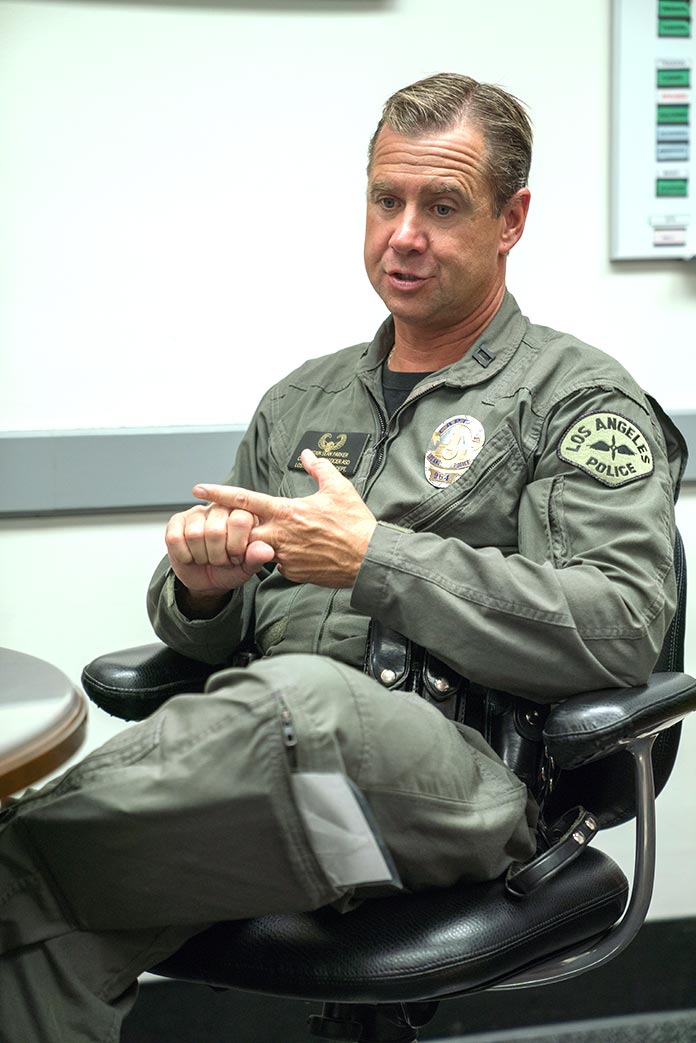
Why did you decide to do that?
It was a offer that provided great opportunities. Learning to fly at this division gives credibility and continuity. It provides a comprehensive and in-depth understanding about aviation. It’s a technical and esoteric arena, and I think from a management side, for a Captain to really understand the nuts and bolts of an aviation unit, it is beneficial for the Captain to fly.
How many hours do you have left?
As we talk today, I have my FAA commercial check ride on Monday, June 24, and then the hope is I meet standard, and I’m successful. [Capt. Parker met the standard and was successful. – Ed.]
You’re almost there.
Right. It’s taken me double the amount of time because [laughing] I didn’t catch on as quickly as some of the other pilots, plus I have to balance my roles. My priority is to the command. My priority is to support the Bureau and the office. Flight school had to be secondary for this to have worked.
Mission in the Air
How many work at Air Support?
About 90 people. We have three Lieutenants. We have 10 Sergeants, which includes Sergeant Is and Sergeant IIs. We have one Chief Pilot, one Chief Tactical Flight Officer [TFO]. We have 36 Line Pilots, 24 TFOs, and we have six Tower Operators. We also have our professional staff that supports our Division– the Adjutant, Secretary and a Clerk, our Reserve Officers, to name a few. We have a Storekeeper and garage attendants. So we have roughly 10 professional staff members to help us with running the division.
Tactical Flight Officers are …
They are the divine voice from above and do some heavy lifting. They sit on the left side of the aircraft, and help guide the pilot to the call’s location. They communicate all the pertinent information to the units on the ground. The TFO helps the officers manage complicated, dangerous, and fast moving incidents. The TFO has remarkable skills.
Okay. Give us a broad overview of what Air Support does, and what it’s tasked to do.
Our mission is to support the resources on the ground for the LAPD. That’s our primary
objective. That includes responding to pursuits, perimeters, foot pursuits, canine searches and high-risk tactical scenes. We are also equipped to conduct special investigative flights and transportation flights.
Our mission is also helping with the COMPSTATs – divisions have certain pieces of real estate where they want us to help provide extra patrol, and we can do that from the air. We respond to Officer-initiated requests. “I need an airship.” We respond to high-priority calls from the radio. If there’s a shooting or an Officer needs help, we respond automatically. And then we have self-initiated actions, where the crew will provide extra patrol in a certain area.
What does Air Support do best?
We bring coordination and control to sometimes out-of-control moments. We help reduce the fear and incident of crime, and help ensure Officer safety. We provide a bird’s-eye view, a larger perspective of an incident, because sometimes these incidents can be monsters. Having an airship above – I believe brings calm, which the TFOs have mastered. And the bad guys – when they hear or see the airship, I have a feeling it causes them to ask themselves, “Do I want to commit the crime now?” because that airship’s above.
I would hope so.
Yes. It’s hard to get away from the aircraft.
What are the special challenges?
Beyond flying and knowing aviation?
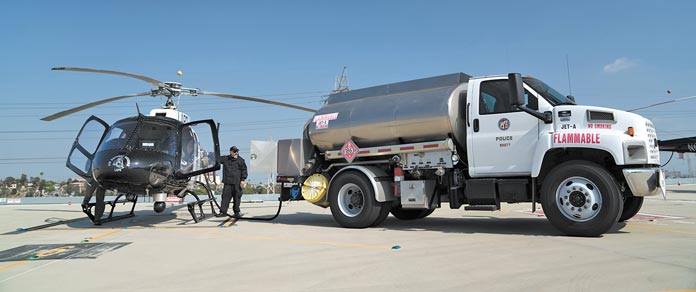
Sure. I assume that flying a helicopter is a big challenge!
It is. Beyond that, the challenges include ensuring that my crews are provided the gold standard in training, flight safety and TFO training. We train our pilots and Tactical Flight Officers every 90 days. That’s far above what the FAA requires.
Wow. Ninety days.
Yes. Due to the inherent danger of aviation, ASD [Air Support] is strongly committed to safety. We strictly follow the aviation industry’s safety philosophy outlined in the Safety Management System. We conduct these check rides and run through emergency procedures, or we’ll run through any type of flight profiles that the pilot wants to practice. The TFOs also can fly the aircraft under emergency conditions, so we’ll put them through the emergency flight training. The challenge is making sure on a regular, consistent basis that we are the gold standard when it comes to law enforcement aviation, because we fly such a unique and very dangerous profile at low altitudes that the pilot needs to be able to make a decision very, very quickly should something happen, so training is critical. And there are always competing interests on budgets, and we make the most out of the scarce funding resources.
You mentioned unique and dangerous profiles – is it more challenging in a City like LA than in other cities, or is it challenging in law enforcement aviation in general?
It’s the number of aircraft we have, the number of people, the amount of hours we fly every year over congested areas and the maintenance demands – that make our operations so challenging. The maintenance demands alone are also part of my day-to-day responsibilities. We have to manage the aircrafts’ time, because there are strict limits. There are 100-hour inspections, 150-hour inspections, annual inspections, and scheduled and unscheduled maintenance. The aviation industry is very strict on the time. For example, with your car you change the oil. The recommendation is every 3,000 miles. I go maybe 5,500 miles before I change the oil. In the aviation industry if it says that you need to have maintenance at the 100- hour mark, it doesn’t mean 101 hours or 105 hours. You have to have it in, so you’re always managing that time. My Watch Commanders must look at the lineup of helicopters, look at the time and make sure that we have enough time to fly through the weekend or that night. We have a constant and consistent relationship with General Services, our maintenance team. They turn the wrenches and keep us alive. We always keep an eye on maintenance.
Recruits and Training
How do you hire Pilots and TFOs? Talk about hiring and training.
The TFO, like the Pilot, goes through an established process for interviews. Candidates interview for the position and are placed in a pool based on their score. I provide a recommendation to my boss of a qualified candidate. The TFOs have a two-month loan, and we evaluate whether the candidate meets the standards during those two months. If they meet standards, they are transferred here for further review and further training. It is very, very difficult. Successful TFOs will have studied and prepared a year out before they come to the division.
For the Pilots, it starts with the interview, and it’s aviation-related. There are prerequisites needed to be eligible for an interview with ASD, but each candidate goes through a similar interview process as the TFO. Based on their interview score, they are placed in either outstanding, excellent or satisfactory categories, and we select from the outstanding pool. Those selected attend our ground school. Here, they begin their flight training, which starts with the basics of one month of ground school learning about the aircraft, aviation, aerodynamics, systems and the hazards of flight. Depending on their abilities, it takes 12 months give or take to successfully complete flight school. Some do it in less time, some do it in more.
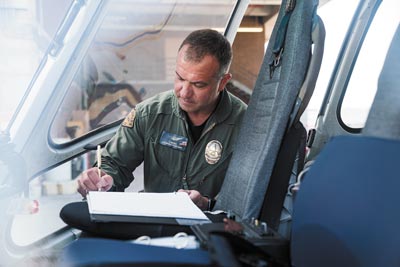
Is there a waiting list to get into Air Support?
We have openings, so we don’t have waiting lists. We’ll have a list of names in the outstanding pool. I’ll provide a recommendation, and then my bosses will decide based multiple factors who is transferred in.
The Sky Wasn’t Calling
Has the dream of flying always been in your blood? [laughing] You’re shaking your head.
I didn’t have an aviation bone in my body. My goal was to stay in operations and remain there; to work other assignments; to take on new, more in-depth responsibilities … but life has a tendency to change. When I was introduced to aviation it really caught my attention. The most difficult thing I’ve ever done in law enforcement is to learn how to fly the helicopter. And the most frightening. Any of you guys fly?
Would love to, but no. Do you still feel that anxiety or fear when you fly even today?
Not so much fear, but it’s staying ahead of the aircraft and having the utmost respect for the machine. If you’re not paying attention, if you’re not watching the gauges and you’re not staying ahead of the aircraft, as we say, bad things can happen quickly.
History
What’s the history of Air Support?
It started in 1956. The first department aircraft was going to be used for traffic – Sig Alerts, traffic collisions and freeway monitoring, and then it evolved. One helicopter evolved into multiple helicopters, and the department found it very useful to help the Officers on the ground enforce laws and apprehend bad guys. And then years ago JPL [the federal Jet Propulsion Laboratory] did a study and determined that a helicopter is what they called a force multiplier – one helicopter reduces the number of Part I crimes and increases the likelihood of arrest, for example, just because of its vantage point. It sees farther than the Officer on the ground can see. Suspects can also see it coming, so it’s a significant deterrent.
I went on a ride-along maybe 10 years ago for Alive!. While we were up for three and a half hours there was a jewelry heist downtown. It was amazing how the helicopter in the air acted like a quarterback. The TFO was closing off streets and commanding out, “Do this and do that, and they’re going over this way.” It was amazing.
That’s a great analogy. The Tactical Flight Officer is the quarterback. He or she is directing the resources and staying in front of the incident as it unfolds.
Air Support, and even the HQ here at Piper Tech, really became known when they made Blue Thunder.
Right.
That movie revolved around preparing for the 1984 Olympics. Are you preparing for the 2028 Olympics?
Air Support will be part of the overall plan in making sure that the Olympics is successful, and we will have resources like any other special-event unit. We do have the ability to downlink, manage crowds and quickly move from one area to the other, helping the Officers in doing whatever it is that they need. So yes, we will be ready for the Olympics.
The Future in the Air
What does the future of Air Support look like? Are new aircraft in the works? Will the division grow?
We have 17 helicopters. I don’t see it increasing beyond that. We could add maybe one or two helicopters. Technology is always improving, so the aircraft that we purchase will have new systems, tools, instruments, and improved performance. Technology moves quickly, and aviation is part of that movement.
Do other cities look to LAPD Air Support for methods or emerging trends or threats? Are other cities looking to you as a model of how to do things?
Yes, they do. We have great partnerships with other law enforcement agencies, certainly the ones that are local. And we’re in regular contact with the LAFD as well as police, Sheriff, CHP, etc. We share aviation issues, and some look to us for our tactics, training, flight attitudes and the best ways to approach a call. It’s not uncommon to have our training cadre and the support section talking to other agencies and discussing best practices and lessons learned. Every year we have a Tactical Flight Officer orientation. Most of the people who attend are from California, but we’ll get people from outside of California to learn from our TFOs.
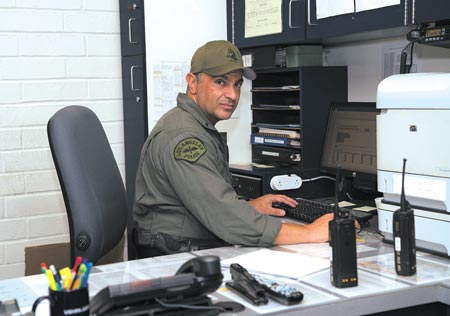
Does having 17 airships make you the biggest in Southern California?
I believe it makes us the largest municipal law enforcement aviation unit.
And you have to do a lot of coordination, I would think, with the Sheriff’s office and the LAFD, DWP, etc. when you’re up in the air.
Yes, aviation in general is crowded in Southern California, specifically in the City of Los Angeles. There are common aviation frequencies that we all use, so you give your location, your altitude and where you’re headed to ensure spacing and separation, and then there are airspace restrictions.
Are you growing? Is the need there for growth in this division?
I believe there will always be a need for a helicopter here in Los Angeles. With just the topography and how the City is laid out, Air Support is such a great tool. It saves Police Officers’ lives. It saves citizens’ lives.
When you say growing, do you mean more people, equipment, or …
Both, or either.
I think we are close to an equilibrium. There are times where that is beyond our control because circumstances change, but we are hitting our stride. There are unexpected events, and sometimes we would like to have more airships available on deck. But when we don’t, we must properly manage the situation so we can have enough in the air. As for people – yes, I can always use more people. We’re fairly close to that balance, and we wouldn’t say no to additional resources.
There are always going to be more challenges out there.
There are.
A Passion for Policing
What do you love about what you do?
It’s certainly very challenging, the most challenging thing I’ve done. I enjoy the people here. They’re very well-read, very sharp. Some are from the Air Force and Naval Academy, others are military veterans … and those who have a penchant for aviation. We have great discussions about aviation. They always keep me on my toes, and I have learned something that I never expected I would. I fell into this world of aviation. It’s such a specialized division, and I enjoy being part of that.
I’ve got fantastic crewmembers, and a fantastic leadership team here. My supervisors are law enforcement managers who can also fly this complicated machine. I am real fortunate to be a part of this skilled and talented group. There’s something new about each flight, at least for me at my stage, and I enjoy that challenge.
Talk about your crew, both airborne and here on the ground.
Their commitment is to aviation, aviation safety and training and currency. They have type-A personalities. They are ambitious and competitive. They want to be the sharpest crewmember, and if they’re not they will train and refine their skills so that the next flight is seamless and perfect. Flying is an unforgiving sport and these crewmembers clearly understand this. They make it look easy, but there’s a lot of stuff that goes on in the cockpit in managing the aircraft and getting it from point A to point B. Although they are Police Officers, they’re also great coaches with tremendous aviation and TFO experience.
Sounds like they take a team approach rather than individual glory.
Oh yes. Every once in a while you might have it, but at the end of the day the ASD team is here to support the mission and support the men and women on the ground.
LAPD’s Air Support Division is the gold standard.
Yes. We are the leaders and the gold standard in law enforcement aviation. We model the approach that other aviation units follow. They look to see what the LAPD is doing. They look to see what types of aircraft we fly and some of our aerial tactics. At least two aircraft are in the air on patrol at every moment. We fly 24 hours a day, seven days a week. The atmosphere and the philosophy here is one of no excuses –we’re going to fly and support the Department’s mission, and we’re going to do it safely.
Capt. Parker, thanks for the interview, and we’ll see you out on the flight deck for our ride-along.
Right. You’re welcome.
BEHIND THE SCENES
Club Director of Marketing Summy Lam (foreground) photographs Capt. Sean Parker, commander of the LAPD’s Air Support Division, on the flight deck above Piper Tech. |






